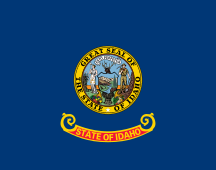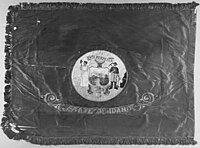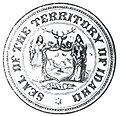
The state flag of Alaska displays eight gold stars, forming the Big Dipper and Polaris, on a dark blue field. The Big Dipper is an asterism in the constellation Ursa Major, which symbolizes a bear, indigenous to Alaska. As depicted on the flag, its stars can be used as a guide by the novice to locate Polaris and determine true north.

The coat of arms of Canada, also known as the Royal Coat of Arms of Canada or, formally, as the Arms of His Majesty The King in Right of Canada, is the arms of dominion of the Canadian monarch and, thus, also the official coat of arms of Canada. In use since 1921, it is closely modelled after the royal coat of arms of the United Kingdom, with French and distinctive Canadian elements replacing or added to those derived from the British version.

The coat of arms of British Columbia is the heraldic symbol representing the Canadian province of British Columbia. The arms contains symbols reflecting British Columbia's British heritage along with local symbols. At the upper part of the shield is the Union Jack, representing the United Kingdom. The lower portion of the shield features a golden sun setting into the ocean, representing the province's location on the Pacific.

The Territory of Idaho was an organized incorporated territory of the United States that existed from March 3, 1863, until July 3, 1890, when the final extent of the territory was admitted to the Union as Idaho.

The flag of Florida consists of a red saltire on a white background, with the state seal superimposed on the center. The flag's current design has been in use since May 21, 1985, after the design of the Florida state seal was graphically improved and officially sanctioned for use by state officials.

The flag of Delaware consists of a buff-colored diamond on a field of colonial blue, with the coat of arms of the state of Delaware inside the diamond. Below the diamond, the date December 7, 1787, declares the day on which Delaware became the first state to ratify the United States Constitution. The colors of the flag reflect the colors of the uniform of General George Washington.

The Commonwealth of Massachusetts has been represented by official but limited-purpose flags since 1676, though until 1908 it had no state flag per se to represent its government. A variant of the white flag with blue seal was carried by each of the Massachusetts volunteer regiments during the American Civil War alongside the National Colors. An exception were the two "Irish regiments", each of which was permitted to carry an alternative green flag with a harp symbol.

The Beehive Flag is the official flag of the U.S. State of Utah. It is a horizontal tricolor with irregular bands of blue, white, and red. The middle white band contains a blue hexagon outlined in gold. Within the hexagon lies a gold-colored beehive, and below it sits a five-pointed white star.

The flag of West Virginia is the official flag of the U.S. State of West Virginia and was officially adopted by the West Virginia Legislature on March 7, 1929. The present flag consists of a pure white field bordered by a blue stripe with the coat of arms of West Virginia in the center, wreathed by Rhododendron maximum and topped by an unfurled red ribbon reading, "State of West Virginia." It is the only state flag to bear crossing rifles, meant to illustrate the importance of the state's fight for liberty during the Civil War as the southern unionist 35th state.

The Great Seal of the State of Hawaii was designated officially by Act 272 of the 1959 Territorial Legislature and is based on the territorial seal. Modifications to the territorial seal included the use of the words "State of Hawaii" at the top and "1959" within the circle. Provisions for a seal for the state of Hawaii were enacted by the Territorial Legislature and approved by Governor William F. Quinn on June 8, 1959. The passage of the Admission Act in 1959, admitted Hawaii as the 50th State of the United States of America on August 21, 1959.

The North American Vexillological Association (NAVA) is a membership organization devoted to vexillology, the study of flags. It was founded in 1967 by American vexillologist Whitney Smith, and others. Its membership of 1,100+ comprises flag scholars, enthusiasts, designers, collectors, conservators, educators, merchants, manufacturers, historians, and hobbyists from most states and provinces of the United States and Canada, and more than 30 other countries.

The Great Seal of the State of Illinois is the official emblem of the U.S. state, and signifies the official nature of a document produced by the state of Illinois. The flag of the state of Illinois consists of the seal of Illinois on a white background, with the word "Illinois" underneath the seal. The present seal was adopted in 1869, the flag bearing the central elements of the seal was adopted in 1915, and the word Illinois was added to the flag in 1970. In a 2001 survey by the North American Vexillological Association, the flag of Illinois was ranked 49th out of 72 different flags of states and territories, mainly in the US and Canada.

The Great Seal of Missouri is used to authenticate certain documents issued by the Government of Missouri. The phrase is used both for the physical seal itself, which is kept by the secretary of state, and more generally for the design impressed upon it. The Great Seal was designed by Robert Wells of Jefferson City.

The Great Seal of the State of Nevada is derived from the Seal of the Territory of Nevada. As Nevada prepared for statehood in 1864, its Constitutional Convention began to formalize the features of the state's official seal. Nevada was admitted as a state on October 31, 1864 by proclamation of President Abraham Lincoln. On February 24, 1866, the motto "Volens et Potens" was replaced by "All for Our Country". The design of the seal was formalized, and Nevada's mineral resources are featured with a silver miner and his team moving a cartload of ore from a mountain in the foreground. A quartz mill stands before another mountain. Transportation and communication are symbolized by a train steaming across the background, with telegraph poles spanning the distance. Agriculture is represented by a sheaf of wheat, a sickle, and a plow in the foreground. Nevada's natural environment is symbolized by a brilliant sun rising over snow-capped peaks. The inner circle of the seal carries the motto "All for Our Country", and Nevada's entry into the Union as the 36th state is shown with 36 stars completing the inner ring. The perimeter of the seal proclaims "The Great Seal of the State of Nevada". Mark Twain was said to have convinced the designer to make the two trails of smoke blow in opposite directions as a prank, which was later rectified when the mistake was realized.

The Seal of the State of Oregon is the official seal of the U.S. state of Oregon. It was designed by Harvey Gordon in 1857, two years before Oregon was admitted to the Union. The seal was preceded by the Salmon Seal of the Provisional Government and the Seal of the Oregon Territory. The state seal is mandated by Article VI of the Oregon Constitution.
The history of Idaho is an examination of the human history and social activity within the state of Idaho, one of the United States of America located in the Pacific Northwest area near the west coast of the United States and Canada. Other associated areas include southern Alaska, all of British Columbia, Washington, Oregon, western Montana and northern California and Nevada.
The coats of arms of the U.S. states are coats of arms, that are an official symbol of the state, alongside their seal. Eighteen states have officially adopted coats of arms. The former independent Republic of Texas and Kingdom of Hawaii each had a separate national coat of arms, which are no longer used.

Historical coats of arms of the U.S. states date back to the admission of the first states to the Union. Despite the widely accepted practice of determining early statehood from the date of ratification of the United States Constitution, many of the original colonies referred to themselves as states shortly after the Declaration of Independence was signed on 4 July 1776. Committees of political leaders and intellectuals were established by state legislatures to research and propose a seal and coat of arms. Many of these members were signers of the Articles of Confederation, Declaration of Independence, and United States Constitution. Several of the earliest adopted state coats of arms and seals were similar or identical to their colonial counterparts.

Emma Edwards Green, born Emma Sarah Etine Edwards (1856–1942), later known as Mrs. Emma Green, was an American painter and designer. She designed the original State Seal of Idaho that was used from 1891 to 1957, a modified version of which is also used on the flag of Idaho. She is the only woman to have designed a state seal.

The flag of Columbus is the official municipal flag of Columbus, Ohio. Its current design is a yellow, white, red vertical triband with the city seal on a blue field. Officially, the flag was adopted in 1929, although it is unknown if the flag was ever flown when it was first adopted.




























